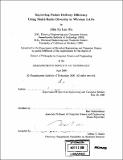Improving packet delivery efficiency using multi-radio diversity in wireless LANs
Author(s)
Miu, Allen Ka Lun, 1977-
DownloadFull printable version (33.06Mb)
Other Contributors
Massachusetts Institute of Technology. Dept. of Electrical Engineering and Computer Science.
Advisor
Hari Balakrishnan.
Terms of use
Metadata
Show full item recordAbstract
Data transmissions in Wireless Local Area Networks (WLANs) often suffer from bit errors that arise from the notoriously complex and time-varying signal propagation characteristics of the wireless medium. A number of physical factors such as attenuation and multi-path are prevalent indoors and can lead to high bit-error rates at the link layer. These in turn lead to packet losses, low throughput, and higher and more variable packet latencies observed at higher layers, degrading the performance of many delay-sensitive and traffic-intensive wireless applications such as games, file-sharing, voice-over-IP, and streaming video. We use the notion of path diversity to develop an approach that improves data delivery efficiency and throughput in presence of transmission errors. Path diversity relies on multiple access points (APs) covering a given area or multiple radios on the user's device (or both). The hypothesis underlying this system is as follows: because frame errors are often path-dependent (e.g., due to multi-path fading), location-dependent (e.g., due to noise), and statistically independent between different transmitting radios, transmissions are likely to succeed from at least one of the available transmitters (transmit diversity). (cont.) Likewise, multiple radios that all receive versions of the same transmission may together be able to correctly recover a frame, even when any given individual radio is not (receive diversity). Using these principles, we design and implement the Multi-Radio Diversity (MRD) system, which leverages the properties of path diversity at the transmitter and receiver to reduce frame loss rates in the link-layer, leading to increased throughput and packet delivery efficiency. We introduce several techniques that make path selection, retransmission, and rate adaptation work efficiently in a MRD system based on the 802.11 MAC. We used commodity PCs and wireless interfaces to build a MRD system and conducted a wide range of indoor experiments. Our experiments measured throughput gains up to three times over conventional schemes without consuming much extra wireless bandwidth.
Description
Thesis (Ph. D.)--Massachusetts Institute of Technology, Dept. of Electrical Engineering and Computer Science, 2006. Includes bibliographical references (p. 115-120).
Date issued
2006Department
Massachusetts Institute of Technology. Department of Electrical Engineering and Computer SciencePublisher
Massachusetts Institute of Technology
Keywords
Electrical Engineering and Computer Science.